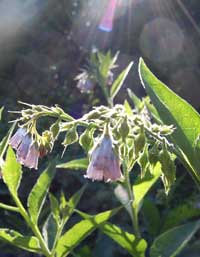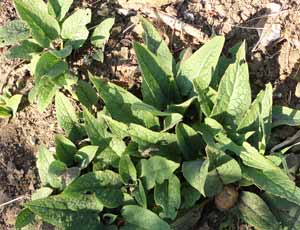Growing Comfrey for Added Garden Fertility

Growing comfrey makes sense for many gardeners as it is such a good source of fertility.
The question is not so much “How to grow comfrey?” as it is how to stop comfrey from growing everywhere! Growing comfrey is really rather easy if you have any spare space in your garden.
It's usually a great idea to grow comfrey as it is such an easy aid to fertility for your garden. Comfrey can easily be made into comfrey tea and fed to the plants or it can be chopped and used as an organic mulch. You can use comfrey as a free fertiliser, liberally spread around the garden to promote plant health and growth.
Picture: Comfrey is a tall beautiful plant and is an asset in the garden
Here's how to grow comfrey
Ideally, you need to be given a chunk of comfrey to plant directly into the soil. Friends who already have comfrey growing in their garden could be persuaded to part with a small piece of root. Failing that, you can buy comfrey in most garden centres which sell herbs.
Make sure that the comfrey is planted deeply enough to bury the roots and water it well. Ensure that it stays well watered for a few days while it gets established.
Comfrey likes free-draining, loamy soil but is not especially fussy. If you have a very hard sub-soil you may need to break it up with a spade for best results. This will give the plant a faster start. Comfrey has a large root system which reaches deep down into the soil.
Comfrey - the invader!
Growing comfrey is often all too easy!
Once it is established it will happily romp around your garden unless you take steps to stop it. The roots will develop spurs which can be broken off to form new plants. It will also readily seed and new plants can appear yards away from the parent plant, at the other side of the garden, even.
The moral is – be careful where you plant comfrey! It is an incredibly useful plant but it is also a space invader which will push other plants out of the way. Comfrey is a garden thug, like mint. It can propagate itself with amazing success and appear, triffid like in your borders and beds.
There is a variety available known as “Bocking 14” which was developed by the Henry Doubleday Research Association. It does not tend to spread so readily, so may be a good choice if you want to be sure of avoiding self-propagation.
Young plants are quite easy to uproot before they have become too big. Older plants will need some spade work to get them out.
Growing comfrey in a bed

If you want to plant a bed of comfrey plants, give young plants between two to three feet space between each one. Incorporate some good quality manure or compost in the bed for a fast start. A damp and remote part of the garden is a good choice. Comfrey plants like plenty of moisture and sunny conditions or half shade.
Growing comfrey in very small gardens is perhaps best avoided - unless you really like it! Comfrey plants can grow very tall and crowd out lesser plants. You may need to hack them back just so that other plants get a chance.
Comfrey is a perennial plant which will come back year after year. It dies back in autumn and may become invisible during the winter months. It quickly re-asserts itself in spring time.
A highly useful plant!
The good news is that comfrey is a plant of incredible utility. It has such deep tap roots that it is able to bring up nutrients from far down in the sub-soil. Many people grow comfrey for this reason alone. It gradually will help you to build up your garden's fertility. Comfrey is rich in potassium and nitrogen, two of the three principal plant nutrients.
Cutting comfrey can be done with a garden sickle or any sharp blade. Wear gloves if you can because the leaves are hairy and slightly prickly and may cause some skin irritation. You can cut growing comfrey at almost any time in the summer months once it is established. Cut small amounts or cut the whole plant down to almost ground level. It will usually bounce back again in no time.
How to make comfrey tea
You can cut comfrey down several times in a season and use the leaves to make "comfrey tea", or liquid fertiliser. Note: This is not for drinking!
There are several ways of making comfrey tea for your garden. Cut the leaves before flowering and drown them in a bucket or tub of water. After a few weeks the leaves will have fermented and broken down and you can drain off the liquid to use as fertiliser.
You should dilute it well before applying it to plants. You can do a similar process without any water – in which case you end up with a thick, dark liquid which needs diluting lots before use. Place the leaves in a waterproof bag or tub and cover them with a lid. Leave for 5 to 8 weeks to decay. Pour off the (smelly) liquid and use it sparingly to add to the watering can as a liquid feed.
You can also add the chopped up leaves to the soil where you are planting potatoes or beans. This will get your crop off to a good start.
I've also seen chopped up comfrey leaves used as a mulch around fruit bushes. One of the members of our community orchard did this. I'll be keeping an eye on how the fruit develops!
You can add comfrey to your compost heap, where it will act as an activator, tending to help the heap to heat up. Don't add a large amount in one layer as it will decay to a slimy mess which will then slow down decomposition of the heap. Rather, add it chopped in with other ingredients.
To avoid the risk of depleting your comfrey plants, it is best to leave them to their own devices later in the year. In autumn the nutrients in the leaves will drain back into the root system to help the plant survive the winter. You may not even be able to see any evidence of the plant in the winter months. In spring it will soon bounce back and come into full vigorous growth.
Sponsored links
Can you eat comfrey?
It is not really advisable to eat comfrey. It contains a toxin which can damage the liver.
There have been calls to ban comfrey tea from herbalist's shelves because of the danger of liver damage. I have cooked up small amounts and eaten them (it was OK) but, as the plant is mucilaginous and rather hairy, I don't think anyone is going to miss it too much as a spring vegetable.
You can certainly use it in animal feed. Hens are partial to it and I have nor heard of any problems with its use this way.
Herbal uses for comfrey
Growing comfrey for herbal use is also a common practice. Comfrey has a notable place in herbalism and homoeopathy. It is regarded as an excellent aid to healing of wounds and broken bones. It has a history of being used as an internal medicine, too. Because of the dangers from alkaloids (PAs or pyrrolizidine alkaloids) this is no longer seen as safe.
You can use comfrey ointments and poultices on unbroken skin to promote healing of sprains, fractures and bruising. My mum had excellent results from using comfrey poultices after a car drove into her and broke her leg. The healing process was faster than expected and she made a full recovery although she was nearly eighty at the time.
Your Backyard Herb Garden: A Gardener's Guide to Growing Over 50 Herbs Plus How to Use Them in Cooking, Crafts, Companion Planting and More is a great book on growing herbs - very practical, with recipes and growing notes included. A great book for anyone starting a herb garden.
Sponsored links
Return from Growing Comfrey back to Organic Gardening
Greenfootsteps Home - for more easy green living ideas
Growing Comfrey for Added Fertility, copyright Greenfootsteps.com 2010
| Tweet |

| Tweet |

Other pages related to growing comfrey that might interest you:
Organic Gardening Compost for A Healthy Garden
Organic Gardening Tips and Techniques for Successful Growing
A Compost Barrel or Compost Tumbler - Which is Best?
Sponsored links
Footprints
- an occasional e-zine from Greenfootsteps
If you would like to receive the e-zine, please just sign up below.






New! Comments
Have your say about what you just read! Leave me a comment in the box below.